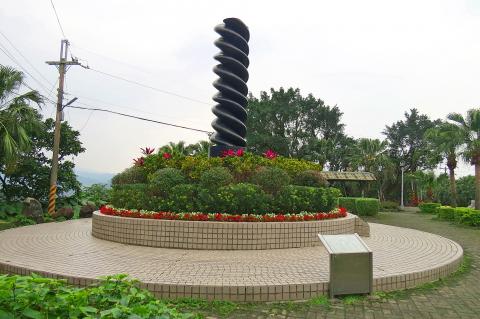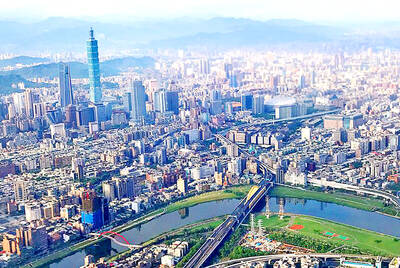A 228 Incident monument in Keelung’s Chung Cheng Park should be moved to Keelung Port, where it would have more historical significance, a family member of a victim said.
Chou Chen-tsai (周振才), whose grandfather, former Keelung City Council deputy speaker Yang A-shou (楊阿壽), was a victim, said the monument would only be meaningful if it is placed near the port, where Chinese Nationalist Party (KMT) soldiers fired at a crowd upon arriving by boat from China.
The 228 Incident began in Taipei on Feb. 27, 1947, when Tobacco Monopoly Bureau agents confiscated contraband cigarettes from a woman, Lin Chiang-mai (林江邁), outside Tienma Tea House (天馬茶房) on Nanjing W Road.

Photo: Yu Chao-fu, Taipei Times
A crowd surrounded the agents after one of them hit the woman on the head with a gun. The agents then fired into the crowd, killing a bystander. Anti-government protests erupted the following day and began to spread throughout the country. The KMT dispatched the army’s 21st Division from China to subdue the unrest.
Troops arriving in Keelung on March 8 began firing indiscriminately into the crowds of protesters with machine guns, and oral accounts by survivors say the harbor and Tienliao River (田寮河) were turned red with blood by the end of the shooting. By March 16, when the assault ended, about 2,000 people were reportedly killed.
Ho Pin-ju (何聘儒), a high-ranking administrative officer of the 21st Division, wrote in his memoirs that troops arriving at the port mounted guns on the boats and began firing at the crowd even before docking.
“Many people had their heads blown off, their legs broken and their internal organs strewn across the ground. Even pregnant women and children were unable to escape the slaughter,” he wrote. “When we docked in the evening, there were traces of blood everywhere around the pier.”
Notable among those killed in Keelung were Yang Kuo-jen (楊國仁), the son of Yang A-shou; Yang Yuan-ting (楊元丁), another Keelung City Council deputy speaker; Badu (八堵) Railway Station station master Lee Tan-hsiu (李丹修); and physician Kuo Shou-i (郭守義).
Many hundreds of other victims went unnamed as soldiers strung their bodies together with metal wiring stabbed through their palms and threw them into the river.
Some were thrown into the water while still alive: One of those who survived was Lin Mu-chi (林木杞), who passed away in 2005.
In an interview with the historian Chang Yan-hsien (張炎憲), Lin said he was strung together with eight other men, blindfolded and dragged down to the water.
The soldiers then fired at the nine and threw them into the water, Lin said, adding that he had not been shot, but was pulled into the water by the weight of the other victims.
After freeing himself from the others, Lin swam to shore.
Taiwan 228 Incident Care Association director-general Yu Hsiang-yao (游祥耀) recounted a story told by a survivor, who had a neighbor operating a Japanese-style public bath.
When a soldier came, the neighbor tried to tell the soldier to wash first before entering the bath, in Japanese fashion, but the soldier responded by yelling at him in a dialect he did not understand. The next day, the soldier returned to the bath, dragged the bathhouse boss into the street and shot him.
Chou said he has visited all 228 monuments in the nation, but thinks they are often too abstract and fail to evoke the massacre in people’s minds.
“The designs are strange and they do not even dare write the numbers ‘228.’ Is it because they are afraid to admit their wrongdoing?” he said.
At the very least, a monument should have some connection to historical facts, he said, adding that imagery such as people being strung together using metal wiring or having their hands and feet tied up would be more appropriate.
Many of the memorials only hold candles or contain messages and are a source of frustration for the families of victims, he said.
Yu said he agrees that putting a monument in Chung Cheng Park is meaningless and that it should be moved to the port.
He said he has spoken with the city government and was told by Keelung Cultural Affairs Bureau Deputy Director Lee Tien-ching (李添慶) that moving the monument would require discussion with members of the bureau and families of the victims, since it is a cultural heritage site.
Additional reporting by Yu Chao-fu

Taipei has once again made it to the top 100 in Oxford Economics’ Global Cities Index 2025 report, moving up five places from last year to 60. The annual index, which was published last month, evaluated 1,000 of the most populated metropolises based on five indices — economics, human capital, quality of life, environment and governance. New York maintained its top spot this year, placing first in the economics index thanks to the strength of its vibrant financial industry and economic stability. Taipei ranked 263rd in economics, 44th in human capital, 15th in quality of life, 284th for environment and 75th in governance,

The Sports Administration yesterday demanded an apology from the national table tennis association for barring 17-year-old Yeh Yi-tian (葉伊恬) from competing in the upcoming World Table Tennis (WTT) United States Smash tournament in Las Vegas this July. The sports agency said in a statement that the Chinese Taipei Table Tennis Association (CTTTA) must explain to the public why it withdrew Yeh from the WTT tournament in Las Vegas. The sports agency said it contacted the association to express its disapproval of the decision-making process after receiving a complaint from Yeh’s coach, Chuang

Control Yuan Secretary-General Lee Chun-yi (李俊俋) tendered his resignation last night, admitting that he had misused a government vehicle, as reported by media. His resignation was immediately accepted by the Control Yuan. In a statement explaining why he had resigned, Lee apologized for using a Control Yuan vehicle to transport his dog to a pet grooming salon on May 20. The issue first came to light late last month, when TVBS News reported that Lee had instructed his driver to take the dog to the salon. The news channel broadcast photos that it said were taken by an unnamed whistle-blower, which purportedly showed the

A former officer in China’s People’s Liberation Army (PLA) who witnessed the aftermath of the 1989 Tiananmen Square massacre has warned that Taiwan could face a similar fate if China attempts to unify the country by force. Li Xiaoming (李曉明), who was deployed to Beijing as a junior officer during the crackdown, said Taiwanese people should study the massacre carefully, because it offers a glimpse of what Beijing is willing to do to suppress dissent. “What happened in Tiananmen Square could happen in Taiwan too,” Li told CNA in a May 22 interview, ahead of the massacre’s 36th anniversary. “If Taiwanese students or